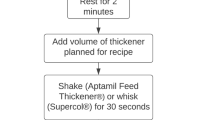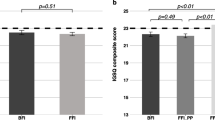Abstract
Improved survival rates of sick or preterm infants have resulted in an increase of observed feeding difficulties. One common method for managing feeding difficulties in infants is to manipulate liquid viscosity by adding thickening agents to formula or expressed breast milk. Concerns regarding the lack of clinical practice guidelines for the use of this strategy have been raised in the literature and in clinical settings for several years. This study aimed to survey feeding clinicians working in major Canadian pediatric centers to identify current practice patterns for use of thickened liquids in managing feeding difficulties of infants and to justify the need for standardization of this practice. A web-based pilot survey was developed using Fluidsurveys software. The questionnaire contained 37 questions targeting the process of prescribing thickeners, choice of thickener, awareness of issues, and inconsistencies raised in the literature about thickener use and how to address them. A total of 69 questionnaire responses were analyzed using descriptive statistics and inductive thematic analysis methods. Our study results indicate that thickened liquids continue to be broadly used to manage feeding difficulties in Canadian infants, despite numerous areas of concern related to their use raised by our respondents. While clear practice patterns for assessment and management were observed among the respondents, some areas of practice did not reflect recent published research or experts’ opinion. Further research to develop a systematic approach for assessment, intervention, and follow-up is warranted to guide clinicians in this complex decision-making process.




Similar content being viewed by others
References
Hawdon JM, Beauregard N, Slattery J, Kennedy G. Identification of neonates at risk of developing feeding problems in infancy. Dev Med Child Neurol. 2000;42:235–9. doi:10.1111/j.1469-8749.2000.tb00078.x.
Newman LA, Keckley C, Petersen MC, Hamner A. Swallowing function and medical diagnoses in infants suspected of Dysphagia. Pediatrics. 2001;6:E106. doi:10.1542/peds.108.6.e106.
Newman LA. Optimal care patterns in pediatric patients with dysphagia. Semin Speech Lang. 2000;4:281–91. doi:10.1055/s-2000-8382.
Clave P, de Kraa M, Arreola V, Girvent M, Farre R, Palomera E, Serra-Prat M. The effect of bolus viscosity on swallowing function in neurogenic dysphagia. Aliment Pharmacol Ther. 2006;9:1385–94. doi:10.1111/j.1365-2036.2006.03118.x.
Inamoto Y, Saitoh E, Okada S, Kagaya H, Shibata S, Ota K, Baba M, Fujii N, Katada K, Wattanapan P, Palmer JB. The effect of bolus viscosity on laryngeal closure in swallowing: kinematic analysis using 320-row area detector CT. Dysphagia. 2013;1:33–42. doi:10.1007/s00455-012-9410-4.
Rempel G, Moussavi Z. The effect of viscosity on the breath-swallow pattern of young people with cerebral palsy. Dysphagia. 2005;2:108–12. doi:10.1007/s00455-005-0006-0.
Khoshoo V, Ross G, Kelly B, Edell D, Brown S. Benefits of thickened feeds in previously healthy infants with respiratory syncytial viral bronchiolitis. Pediatr Pulmonol. 2001;31(4):301–2. doi:10.1002/ppul.1043v.
Gosa M, Schooling T, Coleman J. Thickened liquids as a treatment for children with dysphagia and associated adverse effects: a systematic review. ICAN. 2011;3(6):344–50. doi:10.1177/19414064114076649.
Fucile S, Gisel E, Lau C. Oral stimulation accelerates the transition from tube to oral feeding in preterm infants. J Pediatr. 2002;2:230–6. doi:10.1067/mpd.2002.125731.
Simpson C, Schanler RJ, Lau C. Early introduction of oral feeding in preterm infants. Pediatrics. 2002;3:517–22. doi:10.1542/peds.110.3.517.
Cichero J, Nicholson T, Dodrill P. Liquid barium is not representative of infant formula: characterisation of rheological and material properties. Dysphagia. 2011;3:264–71. doi:10.1007/s00455-010-9303-3.
Stuart S, Motz JM. Viscosity in infant dysphagia management: comparison of viscosity of thickened liquids used in assessment and thickened liquids used in treatment. Dysphagia. 2009;4:412–22. doi:10.1007/s00455-009-9219-y.
Almeida MB, Almeida JA, Moreira ME, Novak FR. Adequacy of human milk viscosity to respond to infants with dysphagia: experimental study. J Appl Oral Sci. 2011;6:554–9. doi:10.1590/S1678-77572011000600003.
Dewar RJ, Joyce MJ. Time-dependent rheology of starch thickeners and the clinical implications for dysphagia therapy. Dysphagia. 2006;4:264–9. doi:10.1007/s00455-006-9050-7.
O’Leary M, Hanson B, Smith CH. Variation of the apparent viscosity of thickened drinks. Int J Lang Commun Disord. 2011;1:17–29. doi:10.3109/13682822.2010.484846.
Beal J, Silverman B, Bellant J, Young TE, Klontz K. Late onset necrotizing enterocolitis in infants following use of a xanthan gum-containing thickening agent. J Pediatr. 2012;2:354–6. doi:10.1016/j.jpeds.2012.03.054.
SimplyThick (2014) SimplyThick Warning. http://www.simplythick.com/warnings/. Accessed 4 Oct 2013.
Health Canada (2010) Recommendation for the Preparation and Handling of Powdered Infant Formula (PIF). http://www.hc-sc.gc.ca/fn-an/nutrition/infant-nourisson/pif-ppn-recommandations-eng.php Accessed 9 Oct 2013.
O’Connor NR. Infant formula. Am Fam Physician. 2009;7:565–70.
Garcia JM, Chambers E 4th, Clark M, Helverson J, Matta Z. Quality of care issues for dysphagia: modifications involving oral fluids. J Clin Nurs. 2010;11–12:1618–24. doi:10.1111/j.1365-2702.2009.03009.x.
Cichero JA. Thickening agents used for dysphagia management: effect on bioavailability of water, medication and feelings of satiety. Nutr J. 2013;1:54. doi:10.1186/1475-2891-12-54.
Garcia JM, Chambers E 4th, Molander M. Thickened liquids: practice patterns of speech-language pathologists. Am J Speech Lang Pathol. 2005;1:4–13. doi:10.1044/1058-0360(2005/003).
Glassburn DL, Deem JF. Thickener viscosity in dysphagia management: variability among speech-language pathologists. Dysphagia. 1998;4:218–22. doi:10.1007/PL00009575.
Cichero JA, Nicholson TM, September C. Thickened milk for the management of feeding and swallowing issues in infants: a call for interdisciplinary professional guidelines. J Hum Lactation. 2013;2:132–5. doi:10.1177/0890334413480561.
DePoy E, Gitlin LN. Introduction to research—understanding and applying multiple strategies. St. Louis: Elsevier Mosby; 2011.
Osborne JW. Dealing with missing or incomplete data. Best practice in data cleaning. Sage publications Inc., California, 2013; pp 105–138. doi:10.4135/9781452269948.
Braun V, Clarke V. Using thematic analysis in psychology. Qual Res Psychol. 2006;2:77–101. doi:10.1191/1478088706qp063oa.
Martin-Harris B, Jones B. The videofluorographic swallowing study. Phys Med Rehabil Clin No Am. 2008;4:769–85. doi:10.1016/j.pmr.2008.06.004.
Bisch EM, Logemann JA, Rademaker AW, Kahrilas PJ, Lazarus CL. Pharyngeal effects of bolus volume, viscosity, and temperature in patients with dysphagia resulting from neurologic impairment and in normal subjects. J Speech Hear Res. 1994;5:1041–59. doi:10.1044/jshr.3705.1041.
Hiss SG, Strauss M, Treole K, Stuart A, Boutilier S. Effects of age, gender, bolus volume, bolus viscosity, and gustation on swallowing apnea onset relative to lingual bolus propulsion onset in normal adults. J Speech Lang Hear Res. 2004;3:572–83. doi:10.1044/1092-4388(2004/044).
Robbins J. Summaries for patients. Can thickened liquids or chin-down posture prevent aspiration? Ann Intern Med. 2008;7:39. doi:10.7326/0003-4819-148-7-200804010-00002.
Popa Nita S, Murith M, Chisholm H, Engmann J. Matching the rheological properties of videofluoroscopic contrast agents and thickened liquid prescriptions. Dysphagia. 2013;2:245–52. doi:10.1007/s00455-012-9441-x.
Nestle Health Science (2013) Resource thicken up clear. http://www.nestlehealthscience.ca/en/products/Pages/Resource-Thicken-Up-Clear.aspx. Accessed 5 May 2014.
Chadwick DD, Stubbs J, Fovargue S, Anderson D, Stacey G, Tye S. Training support staff to modify fluids to appropriate safe consistencies for adults with intellectual disabilities and dysphagia: an efficacy study. J Intellect Disabil Res. 2014;1:84–98. doi:10.1111/jir.12013.
September C, Nicholson TM, Cichero JAY. Implications of changing the amount of thickener in thickened infant formula for infants with dysphagia. Dysphagia. 2014;4:432–7. doi:10.1007/s00455-014-9523-z.
Garcia JM, Chambers E 4th, Matta Z, Clark M. Serving temperature viscosity measurements of nectar- and honey-thick liquids. Dysphagia. 2008;1:65–75. doi:10.1007/s00455-007-9098-z.
Lund AM, Garcia JM, Chambers E 4th. Line spread as a visual clinical tool for thickened liquids. Am J Speech Lang Pathol. 2013;3:566–71. doi:10.1044/1058-0360(2013/12-0044.
Cichero JAY, Steele C, Duivestein J, Clavé P, Chen J, Kayashita J, Dantas R, Lecko C, Speyer R, Lam P, Murray J. The need for international terminology and definitions for texture-modified foods and thickened liquids used in dysphagia management: foundations of a global initiative. Curr Phys Med Rehabil Reports. 2013;4:280–91. doi:10.1007/s40141-013-0024-z.
Acknowledgment
The authors thank Dr. Ben Mortenson for his input on the design validity of the questionnaire.
Conflict of interest
All authors are free of professional areas of conflict of interest.
Author information
Authors and Affiliations
Corresponding author
Appendix: Transcript of the Online Questionnaire
Appendix: Transcript of the Online Questionnaire






Rights and permissions
About this article
Cite this article
Dion, S., Duivestein, J.A., St. Pierre, A. et al. Use of Thickened Liquids to Manage Feeding Difficulties in Infants: A Pilot Survey of Practice Patterns in Canadian Pediatric Centers. Dysphagia 30, 457–472 (2015). https://doi.org/10.1007/s00455-015-9625-2
Received:
Accepted:
Published:
Issue Date:
DOI: https://doi.org/10.1007/s00455-015-9625-2




